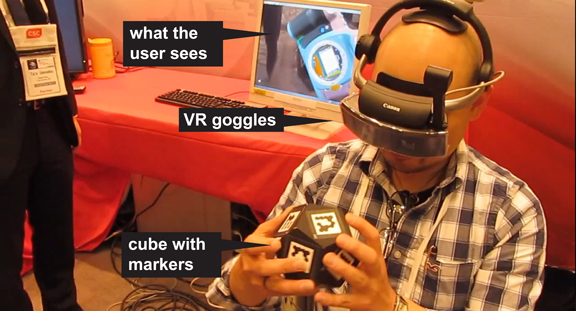Latest News
May 17, 2012
Clearly, the mouse-and-keyboard combo was never meant to be an input system for working with 3D data. It was designed for text input (dating back to the DOS command-line era), but it was adopted by CAD users, for the lack of alternatives. Over time, familiarity gave CAD users the impression that rotating 3D models with a mouse cursor was the standard mode of operation.
But we now have better alternatives, spawned by companies that dare to challenge the status quo in 3D input. Many CAD users are familiar with 3D Connexion, a 3D mice supplier. With a rotating ball that mimics the movements of a 3D object, 3D mice give users a more intuitive way to control and manipulate 3D models in CAD programs.
At Siemens PLM Connection Conference, Germany-headquartered SpaceControl took up a booth to elbow its way into the U.S. market. Its line of 3D mice is quite similar to those sold by 3D Connexion, now considered a veteran in 3D input market. Let’s see if I can help you distinguish the two. 3D Connexion happens to have a space-themed product line: SpacePilot, SpaceMouse, SpaceExplorer, and SpaceNavigator. The German company’s name is SpaceControl, whose product is called SpaceController.
Aside from the 3D mice, the emergence touch-enabled tablets are also redefining how people interact with 3D data. The growing list of CAD viewing mobile apps now available for the iPad and other touch-sensitive tablets, for example, is forcing hardware providers to rethink CAD display. Rotating a model on a multi-touch display is much more intuitive than doing the same with a mouse. Hardware makers like HP are beginning to peddle large displays with multi-touch technologies to CAD users. If multi-touch displays become widespread, viewing and annotating detailed drawings would no longer be the same.
The real cutting edge, as seen by the experimental technologies from Canon on display at the show, is augmented reality. You may know Canon as the famous camera maker, but the company is also delving into what some might call the sci-fi realm. With the use of virtual-reality (VR) goggles that can interpret computer-recognizable markers as 3D data, you can be literally holding 3D data that doesn’t exist in the real world (it must exist at least as a CAD model, of course).
For a video report on the hardware found at Siemens PLM Connection 2012, watch the video clip below (video taken with a Canon PowerShot SX150 IS; footage of Canon demonstration shot by Ken Ohashi, analyst, ISG Strategic Planning Division, Canon U.S.A.):
Subscribe to our FREE magazine, FREE email newsletters or both!
Latest News
About the Author
Kenneth Wong is Digital Engineering’s resident blogger and senior editor. Email him at [email protected] or share your thoughts on this article at digitaleng.news/facebook.
Follow DE






